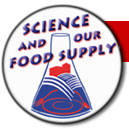 |
 |
||
|
Food Safety For YOU! |
2007 Edition |
|
Your Year 'Round Food Safety Guide
![]()
Check out these food safety tips for work, play, and home -- and remember to spread the word, not the bacteria!
Safe Eats | Let's Do Lunch | Keeping Baby Safe | Know The Code | 4 "Super" Facts
Don't Go There! Inside the DANGER ZONE
Apply the Heat Chart
Fish is properly cooked when it flakes easily with a fork |
It's important to keep food below or above the danger zone, the temperatures at which bacteria can grow. This is usually between 40° and 140° F (4° and 60° C). Some pathogenic bacteria can grow at 32° F (0° C), the temperature at which water freezes. So remember the 2-Hour Rule: Discard any perishable foods left out at room temperature for longer than 2 hours. When temperatures are above 90° F (32°C), discard food after 1 hour!
The temperatures shown in the chart at right are recommended for consumer cooking. They are not intended for processing, institutional, or foodservice preparation.
Putting the 2-Hour Rule into Action
HOT FOODS: When you purchase hot cooked food, keep it hot. Eat and enjoy your food within 2 hours to prevent harmful bacteria from multiplying.
If you're not eating a food within 2 hours -- and you want to keep it hot -- keep the food in the oven with the temperature set at or above 140° F (60° C). Use a food thermometer to check the temperature. Side dishes, like stuffing, must also stay hot in the oven. Covering food will help keep it moist.
COLD FOODS should be eaten within 2 hours of preparation, or refrigerated or frozen for eating at another time.
Many foodborne illnesses probably occur at home. To test this theory, the Food and Drug Administration funded a survey in which scientists videotaped families preparing food in their kitchens. The 100 families initially thought they were being taped on how to make a specific recipe, and they also thought their kitchens were relatively "food-safe." What scientists discovered suggests why foodborne illness hits home for so many Americans.
|
| |||||
One woman handled raw chicken and then fixed a baby's bottle without washing her hands.
|
Dozens of people dried their hands with the same dish towel they used to clean up raw meat juices.
|
One person dropped a baby's bottle in raw eggs and neglected to use soap
when they rinsed the bottle off.
|
Only 45% of the people washed their hands before working in the kitchen and 16% of those who washed didn't use soap.
|
30% did not wash the lettuce they used, and some placed salad ingredients in raw-meat-
contaminated containers.
|
25% of the people didn't know how to tell if chicken was cooked to a safe internal temperature, so they undercooked it.
|
|
| |||||
Don't Get Caught!
If your food preparation and handling practices were "captured on tape," how well would
you do?
Safe Eats | Let's Do Lunch | Keeping Baby Safe | Know The Code | 4 "Super" Facts
Food Safety A to Z Reference Guide
Hypertext updated by dms 2008-JUL-06